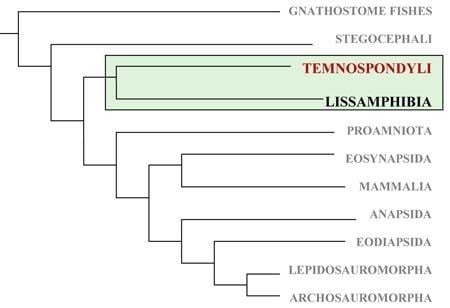Superclass Tetrapoda | Phylum Chordata Rank Subclass | |
 | ||
Clade BatrachomorphaSäve-Söderbergh, 1934 Similar | ||
Batrachomorpha ("Frog form") is a name traditionally given to recent and extinct amphibians that are more closely related to modern amphibians than they are to reptiles. It most often includes the extinct groups Temnospondyli and Lepospondyli. The first tetrapods were all amphibians in the generic sense that they laid their eggs in water. Batrachomorphs composed one branch of these early tetrapods, while the reptiliomorphs composed the other. Modern amphibians are descended from one line of Batrachomorphs, while all other modern tetrapods are descended from the one branch of reptiliomorphs, the amniotes. Amniotes achieved dominance, while all other reptiliomorphs and most batrachomorphs have gone extinct.
Contents
Origin of the term
The name Batrachomorpha was coined by the Swedish palaeontologist Gunnar Säve-Söderbergh in 1934 to refer to ichthyostegids, temnospondyls, anthracosaurs, and the frogs. Säve-Söderbergh held the view that salamanders and caecilians are not related to the other tetrapods, but had developed independently from a different group of lobe-finned fish, the porolepiformes. In this view amphibians would be a biphyletic group, and Batrachomorpha was erected to form a natural group consisting of the "true amphibians" (i.e. frogs in Säve-Söderberghs view) and their fossil relatives. The salamanders and the Lepospondyli was consigned to "Urodelomorpha".
Friedrich von Huene adopted it as a superorder of his subclass "Eutetrapoda" (the lower tetrapods exclusive of the urodeles) and included the orders Stegocephalia (here including a number of labyrinthodonts and anurans). Erik Jarvik, who took over Säve-Söderberghs work and shared his view of the origin of salamanders, used the term more informally, but in a wider sense, to include the ancestral osteolepiform fishes.
Though never a majority view, the notion that tetrapods had evolved twice, together with the usage of the term batrachomorpha, lingered until genetic analysis started confirming the monophyly of living amphibians in the 1990s. Jarviks classification is no longer followed, all living amphibians and their fossil relatives now being classified together in the group Lissamphibia.
Phylogenetics
Michael Benton adopted the term Batrachomorpha to include all living amphibians and extinct relatives more closely related to amphibians than to reptiles. In his scheme, Batracomorpha is a subclass of Amphibia, containing the following orders:
The other groups of tetrapods considered more closely related to amniotes are put in the subclass Reptiliomorpha.
The phylogenetic relationships of Paleozoic tetrapods have not yet been worked out with certainty, and the validity of Batrachomorpha as a clade depends on where other amphibians and early amniotes fit on the evolutionary tree. The actual content of Batracomorpha as cladistically defined is therefore uncertain, and in some phylogenies the clade is redundant (e.g. Laurin 1996).
Anatomy
Batrachomorphs are distinguished by a number of features in the skeleton, including a flat or shallow skull, a fused skull roof with no cranial kinesis, exoccipital-postparietal contact on the occiput, and four or fewer fingers on the hand.
Benton contrasts Batrachomorphs with Reptiliomorphs; both are stem-based clades, but the former constitutes the "amphibian" evolutionary radiation, the latter the contemporary proto-reptilian and early amniote evolution.
In the appendix to Vertebrate Palaeontology, Benton (which combines cladistic and linnaean rankings) has given Batrachomorpha the rank of Subclass in his 2001 edition and Class in the 2004 edition.
